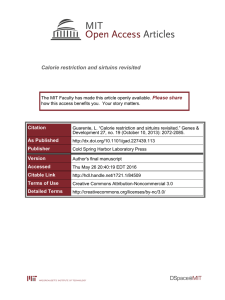SIRT1 suppresses breast cancer growth through downregulation of
advertisement
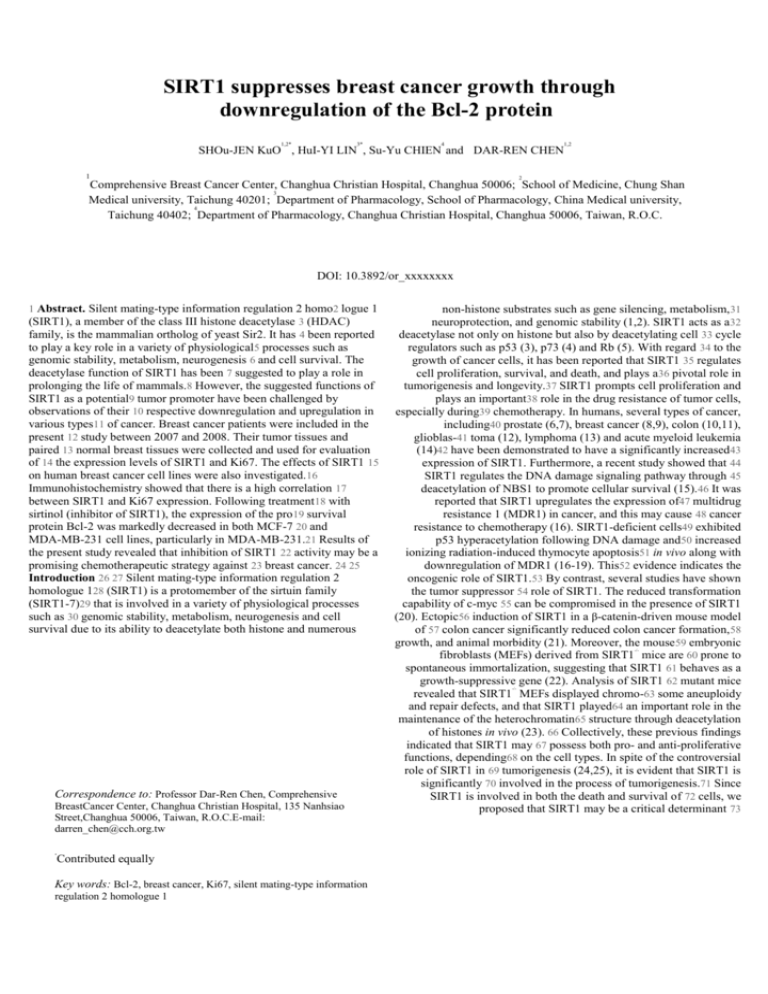
SIRT1 suppresses breast cancer growth through downregulation of the Bcl-2 protein 1,2* 3* 4 SHOu-JEN KuO , HuI-YI LIN , Su-Yu CHIEN and DAR-REN CHEN 1 1,2 2 Comprehensive Breast Cancer Center, Changhua Christian Hospital, Changhua 50006; School of Medicine, Chung Shan 3 Medical university, Taichung 40201; Department of Pharmacology, School of Pharmacology, China Medical university, 4 Taichung 40402; Department of Pharmacology, Changhua Christian Hospital, Changhua 50006, Taiwan, R.O.C. DOI: 10.3892/or_xxxxxxxx 1 Abstract. Silent mating-type information regulation 2 homo2 logue 1 (SIRT1), a member of the class III histone deacetylase 3 (HDAC) family, is the mammalian ortholog of yeast Sir2. It has 4 been reported to play a key role in a variety of physiological5 processes such as genomic stability, metabolism, neurogenesis 6 and cell survival. The deacetylase function of SIRT1 has been 7 suggested to play a role in prolonging the life of mammals.8 However, the suggested functions of SIRT1 as a potential9 tumor promoter have been challenged by observations of their 10 respective downregulation and upregulation in various types11 of cancer. Breast cancer patients were included in the present 12 study between 2007 and 2008. Their tumor tissues and paired 13 normal breast tissues were collected and used for evaluation of 14 the expression levels of SIRT1 and Ki67. The effects of SIRT1 15 on human breast cancer cell lines were also investigated. 16 Immunohistochemistry showed that there is a high correlation 17 between SIRT1 and Ki67 expression. Following treatment 18 with sirtinol (inhibitor of SIRT1), the expression of the pro19 survival protein Bcl-2 was markedly decreased in both MCF-7 20 and MDA-MB-231 cell lines, particularly in MDA-MB-231.21 Results of the present study revealed that inhibition of SIRT1 22 activity may be a promising chemotherapeutic strategy against 23 breast cancer. 24 25 Introduction 26 27 Silent mating-type information regulation 2 homologue 128 (SIRT1) is a protomember of the sirtuin family (SIRT1-7)29 that is involved in a variety of physiological processes such as 30 genomic stability, metabolism, neurogenesis and cell survival due to its ability to deacetylate both histone and numerous non-histone substrates such as gene silencing, metabolism, 31 neuroprotection, and genomic stability (1,2). SIRT1 acts as a 32 deacetylase not only on histone but also by deacetylating cell 33 cycle regulators such as p53 (3), p73 (4) and Rb (5). With regard 34 to the growth of cancer cells, it has been reported that SIRT1 35 regulates cell proliferation, survival, and death, and plays a36 pivotal role in tumorigenesis and longevity.37 SIRT1 prompts cell proliferation and plays an important38 role in the drug resistance of tumor cells, especially during39 chemotherapy. In humans, several types of cancer, including40 prostate (6,7), breast cancer (8,9), colon (10,11), glioblas-41 toma (12), lymphoma (13) and acute myeloid leukemia (14)42 have been demonstrated to have a significantly increased43 expression of SIRT1. Furthermore, a recent study showed that 44 SIRT1 regulates the DNA damage signaling pathway through 45 deacetylation of NBS1 to promote cellular survival (15). 46 It was reported that SIRT1 upregulates the expression of47 multidrug resistance 1 (MDR1) in cancer, and this may cause 48 cancer resistance to chemotherapy (16). SIRT1-deficient cells49 exhibited p53 hyperacetylation following DNA damage and50 increased ionizing radiation-induced thymocyte apoptosis51 in vivo along with downregulation of MDR1 (16-19). This52 evidence indicates the oncogenic role of SIRT1.53 By contrast, several studies have shown the tumor suppressor 54 role of SIRT1. The reduced transformation capability of c-myc 55 can be compromised in the presence of SIRT1 (20). Ectopic56 induction of SIRT1 in a β-catenin-driven mouse model of 57 colon cancer significantly reduced colon cancer formation, 58 growth, and animal morbidity (21). Moreover, the mouse 59 embryonic fibroblasts (MEFs) derived from SIRT1 mice are 60 prone to spontaneous immortalization, suggesting that SIRT1 61 behaves as a growth-suppressive gene (22). Analysis of SIRT1 62 mutant mice revealed that SIRT1 MEFs displayed chromo-63 some aneuploidy and repair defects, and that SIRT1 played64 an important role in the maintenance of the heterochromatin65 structure through deacetylation of histones in vivo (23). 66 Collectively, these previous findings indicated that SIRT1 may 67 possess both pro- and anti-proliferative functions, depending68 on the cell types. In spite of the controversial role of SIRT1 in 69 tumorigenesis (24,25), it is evident that SIRT1 is significantly 70 involved in the process of tumorigenesis.71 Since SIRT1 is involved in both the death and survival of 72 cells, we proposed that SIRT1 may be a critical determinant 73 -/- -/- Correspondence to: Professor Dar-Ren Chen, Comprehensive BreastCancer Center, Changhua Christian Hospital, 135 Nanhsiao Street,Changhua 50006, Taiwan, R.O.C.E-mail: darren_chen@cch.org.tw * Contributed equally Key words: Bcl-2, breast cancer, Ki67, silent mating-type information regulation 2 homologue 1 of cell fate during tumorigenesis. To test this hypothesis, weinvestigated the expression of SIRT1 in tumor breast tissuesand matched normal breast tissues of Taiwanese women, and used breast cancer cell lines to examine the role of SIRT1 in breast tumorigenesis. Table I. Oligonucleotide sequences for RT-PCR. 61 Materials and methods GAPDH F: 5'-GAGTCAACGGATTTGGTCGT-3' 67 R: 5'-GGTGCTAAGCAGTTGGTGGT-3' Patients. A total of 27 breast cancer patients were includedin this study between 2007 and 2008. Tumor tissues and thepaired normal breast tissues were immediately frozen after collection. The cases were diagnosed as infiltrating ductal carcinoma (IDC; n=27) according to the World Health Organization classification system (26). Clinical data were collected retrospectively. All patients provided informedconsent and the study was approved by the InstitutionalReview Board of Changhua Christian Hospital. Antibodies and reagents. The antibodies used for western blotting were: anti-SIRT1 (ab53517; Abcam, Cambridge, uK), anti-β-actin (A-5441) and anti-Bcl-2 (B-3170) (both fromSigma-Aldrich Co., MI, uSA). The primary antibodies usedfor immunohistochemical analysis were: anti-SIRT1 (ab7343;Abcam) and anti-Ki67 (RM-9106-S1; Lab Vision, Fremont,CA, uSA). Chemicals and reagents were purchased fromSigma-Aldrich Co., unless otherwise indicated. Immunohistochemical analysis. The 5-µm sections offormalin-fixed, paraffin-embedded tissues were deparaffinized, rehydrated and the antigen retrieved. The tissuesections were incubated with hydrogen peroxide for 5 minat room temperature to quench the endogenous peroxidase.After blocking in normal goat serum, the tissue sectionswere incubated for 1 h at room temperature with the primary antibodies anti-SIRT1 (1:100 dilution) and anti-Ki67 (1:50dilution), respectively. The slides were then washed with 0.5% Triton X-100 in PBS and incubated with HRP-conjugatedsecondary antibody for 1 h (Vector Laboratories, Burlingame CA, uSA). Nuclei were counterstained with hematoxylin. Asa negative control, normal goat serum was substituted for the primary antibody. All slides were examined by two independent investigators who were blind to the clinical data. Toevaluate the expression of SIRT1 and Ki67 in tumor breasttissue and matched normal breast tissue, the staining intensity was scored from 0 to 3. The ratio of the positively stained area to the total section area was assessed. Reverse transcription-polymerase chain reaction (RT-PCR). Total RNA was isolated from breast tissue using TRIzol Reagent and cDNA was synthesized by MMLV Reversetranscriptase (both from Invitrogen, Carlsbad, CA, uSA).The primer sequences used for PCR are shown in Table I. Synthesized cDNA was amplified and the PCR product was then visualized on 1% agarose gel. The intensity of the PCRproduct was determined by densitometry using the Gel ImageAnalysis System (Alpha Innotech Co., San Leandro, CA, uSA). Cell culture. The human breast cancer cell lines and MCF-7 and MDA-MB-231 cell lines were grown in Dulbecco's modi fied Eagle's medium: Nutrient Mixture F-12 (DMEM/F12) 62Primer Primer sequence 63 6 SIRT1 F: 5'-CATCTCTCTGTCACAAATTCATAGCC-3' 4 65 R: 5'-GTAATTTCTGAAAGCTTTACAGGGTT-3' 66 68 69 SIRT1, silent mating-type information regulation 2 homologue 1; 70 F, forward; R, reverse. 71 72 73 74 supplemented with 10% fetal bovine serum, 2 mM glutamine, 75 100 u/ml penicillin and 100 µg/ml streptomycin (Gibco,76 Invitrogen Ltd., Carlsbad, CA, USA) in a humidified atmo-77 sphere containing 5% CO2 at 37˚C. 78 79 Cell proliferation assay. The cytotoxicity effect of sirtinol on 80 MCF-7 and MDA-MB-231 cells was determined by trypan81 blue dye exclusion and Alamar-blue assays (AbD Serotec,82 Kidlington, UK). 5 Briefly, the cells were plated at a density of 83 2x10 cells in 6-well plates with an increasing dose of sirtinol 84 (10-50 µM in DMSO) or vehicle alone. Following incubation85 for 24 or 48 h, cells were collected and an aliquot of cell86 suspension was mixed with an equal volume of trypan blue,87 and cells were then counted under the microscope. The cell88 viability assay was performed following the instructions of the 89 Alamar blue assay kit. In brief, cells were plated 3 at a density90 of 2x10 cells in 200 µl of complete medium in a 96-well plate 91 and treated with increasing doses of sirtinol or vehicle alone. 92 Each treatment was performed in triplicate. The cells were93 incubated for 24 or 48 h at 37˚C in 5% CO2. Five hours before 94 the end of the culture, the Alamar blue reagent (20 µl in phenol 95 red free RPMI-1640 medium) was added into each well and 96 incubated up to 24 or 48 h. Absorbance of 590 nm wavelength 97 emissions was recorded. 98 99 Flow cytometry analysis. Cell cycle analysis was performed100 5 with flow cytometry. Cells were grown at a density of 101 5x10 cells in 6-well culture plates, treated with different102 concentrations of sirtinol for 24 and 48 h, and maintained at103 37˚C in a 5% CO2 incubator. Following treatment, the cells104 were gently trypsinized, added to the culture medium, and105 pelleted by centrifugation. The cell pellet was resuspended in 106 1 ml PBS, washed at 1,500 x g for 30 min at 4˚C, and fixed107 in ethanol (75% v/v). The cells were then washed with PBS108 and labeled with propidium iodide/RNase A solution. Labeled 109 cells were analyzed by flow cytometry (Epics XL-MCL Flow 110 Cytometry; Beckman Coulter, Inc., Fullerton, CA, uSA) and111 the analyses were performed using WinMDI 2.9 software. 112 113 Western blot analysis. The cells were harvested at 24 and 114 48 h following sirtinol treatment, as described above, and115 washed with PBS, respectively. The cells were lysed with116 ice-cold RIPA lysis buffer (1X TBS, 1% Nonidet P-40, 0.5%117 sodium deoxycholate, 0.1% SDS, 0.004% sodium azide with118 protease inhibitor) and harvested. The lysate was centri-119 fuged at 14,000 x g for 30 min at 4˚C, and the supernatant 120 61 62 63 64 65 66 67 68 69 70 71 72 73 74 75 76 77 78 79 80 81 82 83 84 85 86 87 Figure 1. Representative results of immunohistochemical analysis (x200). Top, p53; middle, Ki67; bottom, SIRT1. The staining intensity from negative to high score is 0 to 3 (from left to right panel). 97 98 99 Results 100 101 Increased gene expression of SIRT1 in breast cancer. The 102 results of immunohistochemical analysis revealed that SIRT1, 103 Ki67 and p53 were localized in tumor and in normal cells104 with varying intensities (Fig. 1). The expression of SIRT1 and 105 Ki67 was significantly higher in tumor tissue than in normal106 tissue (P<0.001 and P<0.005 for SIRT1 and Ki67, respec-107 tively). Twenty-three (82.1%) tumor cases had a higher level108 of SIRT1 and Ki67 proteins. Furthermore, the RT-PCR results 109 showed that the mRNA level of SIRT1 was overexpressed Figure 2. SIRT1 mRNA expression in breast cancer patients. (A) The SIRT1 mRNA expression in breast representative GAPDH actedcompared as an internaltocontrol. 96 normal 111 in110 tumorcases. tissues (29%), the paired (B) The quantitative results. T, tumor tissue; N, paired normal tissue. tissues (Fig. 2). 112 113 Sirtinol induces cell growth inhibition through cell cycle arrest114 in the G0/G1 phase in breast cancer cells. When cells were 115 treated with sirtinol at higher concentrations (30-40 µM),116 cell shrinkage was observed (Fig. 3A). The cell viability was collected and stored at -20˚C until analysis. The protein was 117 reduced by sirtinol in a time- and dose-dependent manner concentration was determined using the bicinchoninic in118 both MCF-7 and MDA-MB-23 cells (Fig. 3B). Flow acidprotein assay (Pierce, Rockford, IL, uSA) according to cytometry 119 analysis was used to examine the effects of sirtinol on themanufacturer's instructions. Fifty micrograms of proteinwere the cell 120 separated by SDS-PAGE and then transferred onto aPVDF membrane (0.4 µm; Millipore, Billerica, MA, uSA).Non-specific interactions were blocked by incubating themembrane with 5% non-fat dry milk in 0.5% PBST for 1 hat room temperature. The membrane was then blotted withanti-SIRT1, Bcl-2, or β-actin antibodies at 4˚C overnight.HRP-conjugated secondary antibodies were added for 1 h,and the immunoreactive signals were then detected using theSuperSignal West Pico Chemiluminescent Substrate (Pierce).The level of protein expression was analyzed using the GelImage Analysis System (Alpha Innotech Co.). Statistical analysis. Statistical analyses were performed using the Student's t-test. A P-value of <0.05 was considered to indi cate a statistically significant difference. All data are shown as the means ± SEM. Statistical calculations were performedusing SPSS software (SPSS, Chicago, IL, uSA). 61 62 63 64 65 66 67 68 69 70 71 72 73 74 75 76 77 78 79 80 81 82 83 84 Figure 3. Effects of sirtinol on cell morphology and cellular viability. (A) Cellular morphological changes following sirtinol treatment after 24 h. (B) Cellswere treated with the indicated doses of sirtinol for 24 and 48 h, respectively. Prior to each time course, cells were added to a 10% Alamar blue culture and incubated for 6 h. Values were obtained from three independent experiments and are expressed as the means *P<0.05 solutionmedium in * P<0.0 between ± SEM. control and sirtinol-treated and *1 cells. 85 86 87 88 89 90 91 92 93 94 95 96 97 98 99 100 101 102 103 104 105 106 107 108 109 110 111 112 Figure 4. Effect of sirtinol on the cell cycle progression of breast cancer cells. (A) MCF-7 and (B) MDA-MB-231 cells were treated with or without increasing concentrations of sirtinol for 24 h, respectively. Cells were fixed, stained and analyzed for DNA content. Data are presented as the means ± SD (n=3). P<0.005 113 and P<0.001 * ** between control and sirtinol-treated cells. 114 115 116 cycle progression of breast cancer cells. As shown in Fig. 4,Sirtinol attenuates the abundance of pro-survival Bcl-2117 sirtinol induced a cell cycle arrest in the G0/G1 phase in both cellprotein. To characterize the molecular mechanisms underlying 118 lines. The proportion of the sub-G1 population also increasedthese different behaviors, we analyzed the protein expression 119 slightly in MDA-MB-231 cells, but not in MCF-7 cells. of Bcl-2 by western blotting. The Bcl-2 protein level in MCF-7 120 61 62 63 64 65 66 67 68 69 70 71 72 73 74 75 76 77 78 79 80 81 82 83 Figure 5. Expression of the Bcl-2 protein in the sirtinol-treated human breast cancer cell lines, (A) MCF-7 and (B) MDA-MB-231. Cells were cultured for the 84 indicated periods with increasing doses of sirtinol (0-40 µM) for 24 and 48 h, respectively. β-actin acted as an internal control. 85 86 and MDA-MB-231 cells was significantly decreased withsirtinol treatment, particularly with 48-h treatment (Fig. 5). Discussion The expression of SIRT1 in breast cancer tissues is controversial. Kuzmichev et al (8) and Sung et al (27) demonstrated an overexpression of the SIRT1, while Wang et al (23) reporteda decreased expression of the SIRT1 protein in breast tumortissues. This study showed that there was an extremely highfrequency of overexpressed SIRT1 in breast tumor tissuescompared to their paired normal tissues (92.59%, n=27)(Fig. 1). Notably, the immuhistochemistry results indicatedthat there is a positive and high correlation of Ki67 and SIRT1 expression (Fig. 1A). It was also found that breast cancer tissue with less proliferative potential (Ki67 scores 0 and 1) exerts a lower expression level of SIRT1, suggesting that SIRT1 could be a predictive marker for the prognosis of breast cancer.Therefore, we proposed that an overexpression of SIRT1 may be involved in breast tumorigenesis, particularly in breasttumor promotion. In general, estrogen receptor (ER)-negative breast canceris often more aggressive and drug-resistant than ER-positivebreast cancer. To examine the roles of SIRT1 in breast cancer cells, two human breast cancer cell lines, MCF-7 (ER-positive) and MDA-MB-231 (ER-negative), were examined. We demonstrated that sirtinol effectively induced proliferation inhibition in both MCF-7 and MDA-MB-231 cells, indicating the promising therapeutic strategy of targeting SIRT1 for breast cancer without having to consider the ER status. Furthermore, inhibition of SIRT1 causes an accumulation of G0/G1 phase and a decrease in both S and G2/M phases(Fig. 3), suggesting the role of SIRT1 in cell cycle progres 87 sion. Furthermore, we explored whether sirtinol inhibits cell 88 proliferation through the apoptosis pathway in MCF-7 and89 MDA-MB-231 cells. Several studies reported that knockdown 90 of SIRT1 or inhibition of SIRT1 activity, such as sirtinol, 91 splitomycin, and cambinol (28-30), causes an apoptotic death92 of cancer cells. 93 Among the proteins involved in the control of the apoptotic 94 pathway, Bcl-2, a pro-survival protein, has been demonstrated 95 to protect cells from apoptosis (31). Bcl-2 inhibits the mito-96 chondrial pathways of apoptosis through local effects at the97 mitochondrial and endoplasmic reticulum membranes (32).98 Furthermore, Bcl-2 was reported to be overexpressed in most 99 breast cancer cells (33,34). Therefore, downregulation of Bcl-2 100 is a potential chemotherapeutic strategy (35). Our data showed 101 that sirtinol promoted apoptosis by decreasing the Bcl-2102 expression in both MCF-7 and MDA-MB-231 cells.103 The results suggest that inhibition of SIRT1 has thera-104 peutic potential as an antitumor strategy. The present study105 confirmed the correlation between SIRT1 and the prognosis of106 breast cancer patients. Markedly, the blockade of SIRT activity 107 causes an anti-breast cancer cell effect through downregu-108 lating the Bcl-2 protein. Therefore, the specific targeting of the 109 SIRT1 protein may be a beneficial chemotherapeutic strategy, 110 particularly for ER-negative breast cancer. 111 112 Acknowledgements 113 114 This study was supported by a grant from the National Science 115 Council (NSC-99-2314-B-040-008-MY3), the Changhua116 Christian Hospital-Chung Shan university joint grant117 (E098Y0068) and the Changhua Christian Hospital-Kaohsiung 118 Medical university joint grant (97-CCH-KMu-014), Taiwan.119 Editorial support was provided by Ms. Yu-Fen Wang, M.S. 120 References 1. 1. Blander G and Guarente L: The Sir2 family of protein deacetylases. Annu Rev Biochem 73: 417-435, 2004. 2. Michan S and Sinclair D: Sirtuins in mammals: insights intotheir biological function. Biochem J 404: 1-13, 2007. 3. Vaziri H, Dessain SK, Ng Eaton E, et al: hSIR2(SIRT1) functions as an NAD-dependent p53 deacetylase. Cell 107: 149-159, 2001. 4. Dai JM, Wang ZY, Sun DC, Lin RX and Wang SQ: SIRT1interacts with p73 and suppresses p73-dependent transcriptional activity. J Cell Physiol 210: 161-166, 2007. 5. Wong S and Weber JD: Deacetylation of the retinoblastomatumour suppressor protein by SIRT1. Biochem J 407: 451-460,2007. 6. Huffman DM, Grizzle WE, Bamman MM, et al: SIRT1 is significantly elevated in mouse and human prostate cancer. Cancer Res 67: 6612-6618, 2007. 7. Jung-Hynes B and Ahmad N: Role of p53 in the anti-proliferative effects of Sirt1 inhibition in prostate cancer cells. Cell Cycle 8:1478-1483, 2009. 8. Kuzmichev A, Margueron R, Vaquero A, et al: Compositionand histone substrates of polycomb repressive group complexeschange during cellular differentiation. Proc Natl Acad Sci uSA 102: 1859-1864, 2005. 9. Zhang Y, Zhang M, Dong H, et al: Deacetylation of cortactin by SIRT1 promotes cell migration. Oncogene 28: 445-460, 2009. 10. Stünkel W, Peh BK, Tan YC, et al: Function of the SIRT1 protein deacetylase in cancer. Biotechnol J 2: 1360-1368, 2007. 11. Kabra N, Li Z, Chen L, et al: SirT1 is an inhibitor of proliferation and tumor formation in colon cancer. J Biol Chem 284: 18210-18217, 2009. 12. Liu G, Yuan X, Zeng Z, et al: Analysis of gene expression and chemoresistance of CD133 cancer stem cells in glioblastoma. + Mol Cancer 5: 67, 2006. 13. Jang KY, Hwang SH, Kwon KS, et al: SIRT1 expression is associated with poor prognosis of diffuse large B-cell lymphoma. Am J Surg Pathol 32: 1523-1531, 2008. 14. Bradbury CA, Khanim FL, Hayden R, et al: Histone deacetylases in acute myeloid leukaemia show a distinctive pattern ofexpression that changes selectively in response to deacetylaseinhibitors. Leukemia 19: 1751-1759, 2005. 15. Yuan Z, Zhang X, Sengupta N, Lane WS and Seto E: SIRT1regulates the function of the Nijmegen breakage syndromeprotein. Mol Cell 27: 149-162, 2007. 16. Chu F, Chou PM, Zheng X, Mirkin BL and Rebbaa A: Control of multidrug resistance gene mdr1 and cancer resistance to chemotherapy by the longevity gene sirt1. Cancer Res 65: 10183-10187, 2005. 17. Cheng HL, Mostoslavsky R, Saito S, et al: Developmental defects and p53 hyperacetylation in Sir2 homolog (SIRT1)-deficientmice. Proc Natl Acad Sci uSA 100: 10794-10799, 2003. 18. Matsushita N, Takami Y, Kimura M, et al: Role of NAD-dependent deacetylases SIRT1 and SIRT2 in radiation and cisplatin-induced cell death in vertebrate cells. Genes Cells 10: 321-332, 2005. Kojima K, Ohhashi R, Fujita Y, et al: A role for SIRT1 in cell growth and chemoresistance in prostate cancer PC3 and Du145 cells. Biochem Biophys Res Commun 373: 423-428, 2008. 2. Yuan J, Minter-Dykhouse K and Lou Z: A c-Myc-SIRT1feedback loop regulates cell growth and transformation. J CellBiol 185: 203-211, 2009. 3. Firestein R, Blander G, Michan S, et al: The SIRT1 deacetylase suppresses intestinal tumorigenesis and colon cancer growth.PLoS One 3: e2020, 2008. 4. Chua KF, Mostoslavsky R, Lombard DB, et al: Mammalian SIRT1 limits replicative life span in response to chronicgenotoxic stress. Cell Metab 2: 67-76, 2005. 5. Wang RH, Sengupta K, Li C, et al: Impaired DNA damageresponse, genome instability, and tumorigenesis in SIRT1 mutant mice. Cancer Cell 14: 312-323, 2008. 6. Lim CS: SIRT1: tumor promoter or tumor suppressor? MedHypotheses 67: 341-344, 2006. 7. Li K and Luo J: The role of SIRT1 in tumorigenesis. N Am J Med Sci 4: 104-106, 2011. 8. Ferraro E, Pulicati A, Cencioni MT, et al: Apoptosome-deficient cells lose cytochrome c through proteasomal degradation butsurvive by autophagy-dependent glycolysis. Mol Biol Cell 19:3576-3588, 2008. 9. Sung JY, Kim R, Kim JE and Lee J: Balance between SIRT1and DBC1 expression is lost in breast cancer. Cancer Sci 101:1738-1744, 2010. 10. Heltweg B, Gatbonton T, Schuler AD, et al: Antitumor activityof a small-molecule inhibitor of human silent information regulator 2 enzymes. Cancer Res 66: 4368-4377, 2006. 11. Ota H, Tokunaga E, Chang K, et al: Sirt1 inhibitor, Sirtinol,induces 30. Ford J, Jiang M and Milner J: Cancer-specific functions of SIRT1 senescence-like growth arrest with attenuated Ras-MAPKsignaling enable human epithelial cancer cell growth and survival. Cancer Res 65: in human cancer cells. Oncogene 25: 176-185, 2006. 10457-10463, 2005. 1. Reed JC: Bcl-2-family proteins and hematologic malignancies:history and future prospects. Blood 111: 3322-3330, 2008. 2. Hockenbery DM: Targeting mitochondria for cancer therapy.Environ Mol Mutagen 51: 476-489, 2010. 3. Amundson SA, Myers TG, Scudiero D, Kitada S, Reed JC andFornace AJ Jr: An informatics approach identifying markersof chemosensitivity in human cancer cell lines. Cancer Res 60:6101-6110, 2000. 4. Zhang M, Guo R, Zhai Y and Yang D: LIGHT sensitizesIFNgamma-mediated apoptosis of MDA-MB-231 breast cancercells leading to down-regulation of anti-apoptosis Bcl-2 familymembers. Cancer Lett 195: 201-210, 2003. 5. Kelly PN and Strasser A: The role of Bcl-2 and its pro-survivalrelatives in tumourigenesis and cancer therapy. Cell Death Differ 61 62 63 64 65 66 67 68 69 70 71 72 73 74 75 76 77 78 79 80 81 82 83 84 85 86 87 88 䘀椀最甀爀攀..刀攀瀀.攀猀攀渀琀愀琀.瘀攀.攀猀甀氀琀猀漀昀.洀洀甀渀漀..猀琀漀挀.攀洀.挀愀氀愀渀愀氀.猀.猀... ...漀瀀.瀀...洀...氀攀......戀漀琀琀漀洀...刀.....攀猀 89 琀愀.渀.渀最.渀琀攀渀猀.琀.昀.漀洀渀攀最愀琀.瘀攀琀漀..最.猀挀漀.攀.猀 琀漀..昀.漀洀氀攀昀琀琀漀..最.琀瀀愀渀攀氀.. 90 91 92 93 94 95 96 97 98 99 100 101 102 103 104 18: 1414-1424, 2011. 105 106 107 108 109 110 111 112 113 114 115 116 117 118 119 120
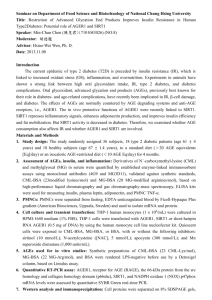
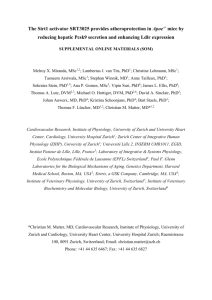


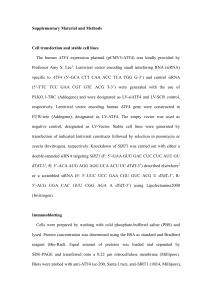

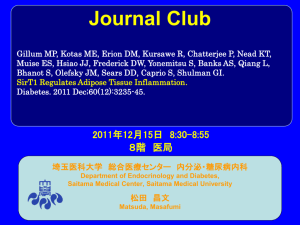

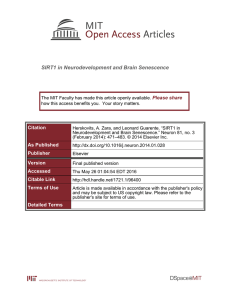
![SIRT1 Regulates Thyroid-Stimulating Hormone Release by Enhancing PIP5K[subscript gamma] Activity through](http://s2.studylib.net/store/data/011685278_1-09341b1c2f687c801d0cfd5a31ec3d15-300x300.png)
